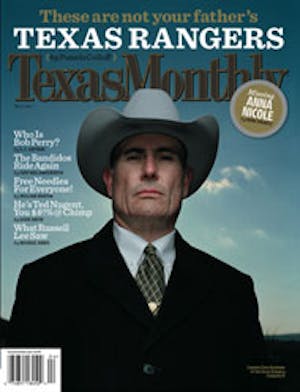THANK YOU, MICHAEL HALL, for opening your “football-loving soul” to the NASCAR way [“EEEEEEAAAAOOOOWWW!!!,” February 2007]. Most of the time, NASCAR fans get looked down upon, but you came, saw, and felt what millions of others love—one hell of a good time.
STEPHEN HUGHES
Pflugerville
AS A LONGTIME MOTOR SPORTS enthusiast who has had little interest in NASCAR since its cars stopped having any stock parts, I feel that NASCAR occupies about the same stature in the world of motor sports as professional wrestling does in non-motorized sports. That said, it is clear that Mr. Hall has no idea what supercharging actually is. NASCAR has never allowed either supercharging or turbocharging, and only a few road cars have ever actually had superchargers fitted by the manufacturers. Hall is a good example of why NASCAR has little appeal to people who understand the engineering involved in racing.
JOHN VANLANDINGHAM
via e-mail
A Town Divided
YOUR ARTICLE “The Beating of Billy Ray Johnson” gives Linden a bad reputation [February 2007]. The situation did happen here and happens in almost any town at one time or another, but don’t blame the whole town. The majority of the residents are loving, friendly, and caring people. The color of our skin is not a problem.
BILLYE EARLY
Linden
BILLY RAY, because not one of the backwoods bubbas in Linden will accept responsibility or admit any wrongdoing, I would like to speak up for the millions of other white boys who grew up in rural Texas. What those boys did to you was wrong. Billy Ray, I am sorry.
J. FREDERICK
Dallas
THIS PIECE reminds me of the old Frank Zappa line “I’m not black, but there’s a whole lots a times I wish I could say I’m not white.” The incident in Linden, while not as ultimately tragic, does recall the incident a few years back in Jasper and prompts one to think, “I’m not ashamed to be from Texas, but there are times I’m glad to say I’m not from East Texas.”
TOM GIBBS
Taylorsville, Kentucky
Check Plus
THANKS FOR THE STORY on the two chess prodigies [“Check Mates,” February 2007]. Back in the early nineties, we at Schanen Estates Elementary, in Corpus Christi, started a chess club. We met J. J. Guajardo in Brownsville, and he inspired us to compete. One of our students, a second-grader, became number one in Texas at the second-grade level. Thank goodness for folks like Mr. Guajardo. He is much more than a teacher. He is a hero.
ESTHER BONILLA READ
via e-mail
Patients Are a Virtue
THROUGH THE COURTESY of a friend, I was able to read Dr. Abraham Verghese’s essay on teaching medicine by the bedside [“Bedside Manners,” February 2007]. He highlights an important retrogressive trend that came into prominence with the development of the computerized tomography scanner. I was at the Institute of Neurology at Queen Square, in London, for a year (1974—1975) and was able to witness the sadness within British neurologists of the old school as they witnessed the jettisoning of invaluable clinical tools in favor of the scans.
Within a few years, the trend had invaded India, and with increasing numbers of scanners (CT and MR), we see consultants who should know better asking the referring family physician to send the patient to a scanner first and arrive at the consultant’s office with the envelope containing the scans. No prize for guessing which came first for the consultant—examination of the patient or a study of the films.
In neurology we witness major complications as a result of this trend. Incidentally, detected lesions that are unlikely to progress or plague the patient are treated by major neurosurgery. As will happen, some of these unfortunate patients suffer complications following the unnecessary surgery with the development of handicaps that were not there in the first place.
SUNIL PANDYA
Mumbai, India
WHAT A BEAUTIFUL ARTICLE. While restoring one’s faith in the medical profession, it clearly shows how much has been lost with the advent of technological innovations.
My father was an MD of the old school. I remember that whenever I or my younger brothers and sisters complained of illness, real or imaginary, he would ask us to lie down. With the stethoscope out of sight, he would patiently ask some questions while examining our face and asking us to lift our shirts. He would follow by lightly kneading the affected part and performing percussion and auscultation. He would then inform us of the results of his examinations. We always considered it magic that he could feel and hear with the tips of his fingers.
JOSÉ GONZÁLEZ JÁUREGUI
Houston
Degrees of Separation
I AM WRITING in response to Sarah Bird’s February article “Tour de Farce,” in which she reveals her bias by inferring that parents whose children attend a community college are giant losers in the competition to enroll in “good colleges” and sardonically uses a mock bumper sticker, “My Son and My Money Go to East Pan Gravy Community College,” to emphasize her point. Her attempt to be humorous is done at the expense of nearly 600,000 students enrolled in community colleges in Texas.
For those families who cannot afford to send their children to the so-called upper-tier universities or those traditional students who need a more nurturing environment in which to begin their college careers or those nontraditional students who are seeking another chance to make something of their lives, thank goodness for community colleges. They provide access and opportunity for Texans from all walks of life.
As a Texas dad, I am very proud that my daughter began her college career at a community college and is now a successful student at a university in Texas. If Ms. Bird wants her son to get a first-class start in his college career, she might consider this bumper sticker: “My Son Goes to a Community College and You Won’t Believe How Much Money I’ve Saved.”
STEVE THOMAS
President, Vernon College
Vernon






